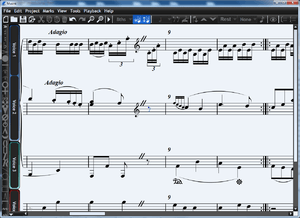Musink
|
Musink music editing interface | |
| Developer(s) | Lee Reid[1] |
|---|---|
| Initial release | 2012 |
| Development status | Active |
| Operating system | Microsoft Windows |
| Size | ≈20MB |
| Available in | English |
| Type | Application software, music engraving, music software, scorewriter |
| License | Freeware |
| Website | http://musink.net |
| Standard(s) | MIDI, PDF, XPS, PNG |
Musink is a scorewriting computer program for Windows. It is a WYSIWYM (What You See Is What You Mean) editor, with automated music- and page-layout functionality.[2] Two versions of Musink exist: Musink Lite, which is freeware; and Musink Pro, which is not free but contains additional features.
User interface
To enter notes on the score, the user Musink clicks 'guide notes' - notes which appear under the cursor but do not appear in the final score.[3] Musink automatically determines note and rest durations. As such, Musink does not require the 'note toolbox' tool which appears in similar programs.
The user interface is WYSIWYM and displays musical notes on screen in a long ribbon. Voices of staves are separated during editing. When a score is published to PDF, music is automatically laid out on a page, voices are combined and note positions are fine tuned.
Functionality

Musink automatically takes care of many of the basic rules of music notation, such as correct stem direction and vertical alignment of multiple rhythmic values, as well as established rules for positioning of noteheads on chords. Stem directions and mark positions can also be manually adjusted. Projects can be split into unrelated sections, allowing creation of documents such as exercise books.[4]
Drum and percussion support
Musink supports a number of marks and settings specific for drummers. These include sticking marks, ghost note brackets, flam-style gracenotes, and special notehead shapes. Layout settings for staves can also be switched to 'drum default' layout rules.
MIDI
Projects can be played from Musink during editing through connected MIDI devices, including VST instruments. Project sections can be exported as MIDI files. The software will also export bars of music as MIDI loops.[5] Musink Pro additionally supports live MIDI recording, MIDI step-input, and MIDI-file import operations.[6]
PDF creation

Musink allows projects to be exported as PDFs, XPS documents and PNG files. Publishing to one of these formats is completely automated, including the arranging of music into rows and pages. A project can be published any number of times, and can be edited after publishing.
Templates
Musink uses 'templates' which define how scores appear when they are published. Templates define aspects of the pages such as:
- Fonts and font sizes
- Notation size
- Page and gutter margins
- Placement of titles
- Title pages
- Vertical spacing between rows and sections
When publishing, the user can choose which template they would like their score to be published with. Musink ships with 16 templates, including two for children. It also provides template import functionality.
See also
References
- ↑ "About". Musink Limited. Retrieved 2012-09-01.
- ↑ "Frequently Asked Questions". Musink Limited. Retrieved 2012-09-01.
- ↑ "Short Musink Tutorial: Guides, Notes, and Tuplets". Retrieved 5 October 2012.
- ↑ "Sections – Musink Help". Musink Limited. Retrieved 2012-09-01.
- ↑ "MIDI Export". Musink Limited. Retrieved 2012-09-01.
- ↑ Reid, Lee. "Musink Pro Feature Preview". Musink Blog. Musink Limited. Retrieved 29 June 2013.
